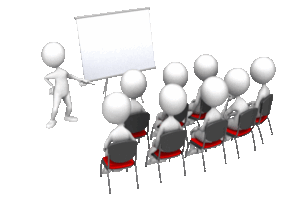Company Training – Do It Yourself Or Outsource It?

 Maybe you want to develop your own materials and conduct your company training classes.
Maybe you want to develop your own materials and conduct your company training classes.
Maybe you want to hire me or someone else for those tasks.
Regardless, creating effective training presentations requires some in-depth thought and planning. I’m going to help you begin that process here and now.
FOCUS

The guidelines in this series on training can help you focus clearly as you get started. The concepts apply equally in preparing you to:
- create and present classes
- evaluate and hire training contractors
- select venues.
The Principles Apply to More Than Company Training
The considerations are similar for a speech or single class presentation and longer courses or class modules. Event Coordinators also can benefit from these tips and reminders as they plan retreats, conferences, courses, and training. In addition, many of the concepts are equally applicable to Zoom (online) presentations, in-person events, and a mixture.
Note: this is the first in a series about how to create effective classes, training, and other presentations. I’m trying to spare your eyes from reading fatigue. Each sub-topic could be a whole book or a whole post! Click Here for additional info about classes and training, including the next in this series of articles.
Training Scope and Limitations
 Begin by creating a general outline of your thoughts and goals. That outline is not a law! You don’t have to adhere to it!
Begin by creating a general outline of your thoughts and goals. That outline is not a law! You don’t have to adhere to it!
 It is food for thought and an aid in getting things organized. You will change the content and flavor by adding or omitting ingredients as you cook it until it’s well done. In that process, you will define the scope and limitations of the subject matter you cover.
It is food for thought and an aid in getting things organized. You will change the content and flavor by adding or omitting ingredients as you cook it until it’s well done. In that process, you will define the scope and limitations of the subject matter you cover.
The Training or Speech Topic

Don’t be too nebulous and expansive. Rather than choosing “World Peace” as an overly broad topic, select one aspect. Here are some examples.
- Teach people how to meditate as a contribution to world peace. (It’s easier than you think.)
- Train employees in negotiation and mediation skills to bring peace to a contentious workplace.
- Talk about how learning a new technology, in a safe and non-judgmental environment, will give them job security and peace of mind as they take on new job responsibilities.
Choose a topic that is as relevant as possible to the daily lives, work functions, and/or interests of your trainees. That, of course, implies you need to know some details about your audience.
Effective Company Training is About Excellent Communication

- Often, in training, we want to correct an individual’s or department’s behavior.
- A different purpose is to introduce or inculcate new skills.
- We may want to “tap into” or expand on existing creativity, knowledge, or problem-solving skills in our students.
- Sometimes, we just want to share new things we’ve learned.
Intended goals, according to the Business Dictionary, include the objectives of:
- Creating awareness
- Imparting knowledge
- Projecting an image
- Shaping attitudes
- Stimulating a want or desire, and/or
- Effecting a sale.
First, define your purpose for each training segment, so that you can orient the presentation content toward meeting related goals.
It Takes Two (Or More) to Communicate
The components of training are not just a speaker finding a venue and then presenting. For in-depth learning to take place, both trainer and trainee must have:
- Active listening skills
- Ability to anticipate objections and to answer those negatives before they are solidified beyond correction in the person’s mind
- Receptivity to learning
- Willingness to understand new information or points of view or which conflict with pre-existing beliefs
- A safe and supportive environment.
Uh Oh! … BUT ~ The Show Must Go On…
The truth is that we sometimes have to teach or train people who are resistant to us, to the topic, or to “the rules” of the gathering.
 This is especially true if trainees are fearful that they cannot learn sufficiently well to perform new tasks in a work environment. Already feeling insecure, they are afraid of looking “stoopid” in front of others if they don’t understand everything in the first Nano-second and without further explanations. Many won’t ask questions, even when understanding the basics is a requirement for more advanced learning.
This is especially true if trainees are fearful that they cannot learn sufficiently well to perform new tasks in a work environment. Already feeling insecure, they are afraid of looking “stoopid” in front of others if they don’t understand everything in the first Nano-second and without further explanations. Many won’t ask questions, even when understanding the basics is a requirement for more advanced learning.
 Speakers tend to focus on themselves, their responsibilities as presenters, and what they are trying to teach, plus logistics. Consequently, as a trainer, you might not realize it, but some participants literally are praying that they won’t look foolish and that they will be able to understand the content that they truly don’t believe they can comprehend.
Speakers tend to focus on themselves, their responsibilities as presenters, and what they are trying to teach, plus logistics. Consequently, as a trainer, you might not realize it, but some participants literally are praying that they won’t look foolish and that they will be able to understand the content that they truly don’t believe they can comprehend.
Have patience. Be sensitive. Try to phrase things in a way that suits individual needs. This kind of situation provides an opportunity for the apt use of ice-breakers, among other techniques.
It helps, too, if trainers and trainees have shared goals, values, ethics, and respect for classroom etiquette. Oh well!

Please silence your phones and do not record the presentation. (“Yeah, right!”)
Consider Generational and Cultural Differences
 It also is true that young people may be perfectly comfortable when learning things through online videos. For example, some learn easily from looking at quickly moving screenshots containing the image of a cursor moving from point to point of menu navigation – often without any narration. An hour’s worth of lecture is compressed into a three-to-five-minute video with the menu words too small to read for anyone but a worm.
It also is true that young people may be perfectly comfortable when learning things through online videos. For example, some learn easily from looking at quickly moving screenshots containing the image of a cursor moving from point to point of menu navigation – often without any narration. An hour’s worth of lecture is compressed into a three-to-five-minute video with the menu words too small to read for anyone but a worm.
 Conversely, older adult learners might prefer sharing experiences as the way they learn best in an in-person environment. They might prefer a lecture and handouts to a video and nothing tangible to take with them to study. Unless they are already familiar with software menus and navigation protocols – or even if people of any age just have poor eyesight – they cannot follow swiftly moving arrows in a presentation without explanations, especially on a small screen.
Conversely, older adult learners might prefer sharing experiences as the way they learn best in an in-person environment. They might prefer a lecture and handouts to a video and nothing tangible to take with them to study. Unless they are already familiar with software menus and navigation protocols – or even if people of any age just have poor eyesight – they cannot follow swiftly moving arrows in a presentation without explanations, especially on a small screen.
 That said, I offer a word of caution: don’t stereotype! Learn as much as you can about the people (either as individuals or as a group) before you start compiling your presentations.
That said, I offer a word of caution: don’t stereotype! Learn as much as you can about the people (either as individuals or as a group) before you start compiling your presentations.
 Other differences are affecting the ability to receive and retain training. They relate to culture, education, sociology, and the field of work. Individual attention may be required.
Other differences are affecting the ability to receive and retain training. They relate to culture, education, sociology, and the field of work. Individual attention may be required.

 Similarly, you could change your training approach for business-to-customer classes versus business-to-business classes.
Similarly, you could change your training approach for business-to-customer classes versus business-to-business classes.
For us to design successful training presentations, we need to consider the pros and cons of various options.
Characteristics of the Trainees / Audience
To Whom Are You Speaking?
Be aware of the level of education and language skills of the trainees.
 I once had to conduct training on the same complex subject (government procurement policies, procedures, and related software navigation) for people who were groundskeepers, administrative staff, and Ph.D. instructors at Northern Virginia Community College.
I once had to conduct training on the same complex subject (government procurement policies, procedures, and related software navigation) for people who were groundskeepers, administrative staff, and Ph.D. instructors at Northern Virginia Community College.- “NOVA” is the second-largest community college in the USA. Each person had very different roles on campus and needed to know only portions of the overall content.
- The best-case scenario would have been to divide into groups. This approach would have allowed content and style to be customized to the very different needs and sophistication of each.
- Since that was not possible because of time constraints, I had to make sure I used a variety of language and examples to which people in each department could relate.
- In this instance, every person needed to know exactly the same information and to pass certification requirements in that subject matter. Had that not been the case, I might have had the opportunity to use breakout sessions. In those groups, the participants could get assignments or exercises solely pertinent to information for which they were responsible. (Determine your options as you create your presentations.)
 The subject matter was tough and potentially boring, but “a good time was had by all.”
The subject matter was tough and potentially boring, but “a good time was had by all.”
A further advantage of having such a diverse group of trainees in the same class was that they began to understand one another’s perspectives in ways they would not have done without this in-person exposure to one another’s questions and viewpoints.
Each person had a piece of the puzzle that made the whole operation work well for customers.
Respect the Trainees
Be mindful of the general frame of reference of the trainees and accommodate that in your approach to creating classes, training materials, and scenarios.
 Respect your students. For example, if you’re teaching computer skills to people who fear technology, the approach should be different from that used to train people who thrive on the use of technology in their daily lives.
Respect your students. For example, if you’re teaching computer skills to people who fear technology, the approach should be different from that used to train people who thrive on the use of technology in their daily lives.- Do not use “jargon” in your presentations, unless the trainees already are thoroughly familiar with that jargon, acronyms, abbreviations, etc.
- Be as formal or informal as needed to communicate effectively with the particular group you are training.
Company Training Classes for Groups
It’s Not Just Training; It’s a Management Tool for Success
 If possible, seek 360-degree input. Even if you’re training on a technical subject, company policies and procedures likely apply. Different folks have responsibility for differing parts of the organization’s mission and for customer service.
If possible, seek 360-degree input. Even if you’re training on a technical subject, company policies and procedures likely apply. Different folks have responsibility for differing parts of the organization’s mission and for customer service.
Management Goals Versus Front-Line Realities
It is important to know the goals and objectives of upper management or a Board of Directors. It’s also critical to know what challenges “worker bees” face, particularly as relates to customer service. Trainees may know the real-world situation better than company leadership, but upper management may need to meet specific requirements.
 By listening to people from all affected parts of an organization (and to customers, if possible), you can create the best training to serve the purpose at hand.
By listening to people from all affected parts of an organization (and to customers, if possible), you can create the best training to serve the purpose at hand.
In that process, you also have an opportunity to explain the situation and needs of each level OF the organization TO each level of the organization. This can enhance the sense of shared goals, objectives, and desire for success.
Once you have all that input, however, it is time to do the work with a very limited number of “co-conspirators.” Remember: Too Many Cooks Can Spoil the Broth.”

Company Training Classes for Individuals
 If this training is to correct a performance issue, discuss the training needs and objectives during the performance evaluation. After describing any shortcomings, provide details needed in the Next Steps to correct a deficiency. Specify exact milestones, deadlines, and quality/quantity of achievement expected and follow up without fail.
If this training is to correct a performance issue, discuss the training needs and objectives during the performance evaluation. After describing any shortcomings, provide details needed in the Next Steps to correct a deficiency. Specify exact milestones, deadlines, and quality/quantity of achievement expected and follow up without fail.
There might be no deficiency, but you or the employee would like for the person to qualify for a promotion that requires expanded skills. In each case, you should provide follow-up meetings and training opportunities.
The Company’s Training Facilities
(Real or Imagined = Physical or Online)
 I was going to talk just about the things you need to scout out about the training venue. However, I’ve decided to go above and beyond the call of duty and give you a checklist I developed some time ago for presenters to use in thinking about their approaches to a speech. Because that is so long, thorough, and complex, I’m putting this wonderful aid into a separate blog, so please come back for more! You can find it in the 2nd in this series on company training.
I was going to talk just about the things you need to scout out about the training venue. However, I’ve decided to go above and beyond the call of duty and give you a checklist I developed some time ago for presenters to use in thinking about their approaches to a speech. Because that is so long, thorough, and complex, I’m putting this wonderful aid into a separate blog, so please come back for more! You can find it in the 2nd in this series on company training.
If you have questions or want to book me, email me at MyPersuasivePresentations@gmail.com.Thanks for your interest!
Contact Me For a FREE Initial Consultation.
Let’s Chat First in a Sip & Share Session on Zoom
I hope this has been helpful to you. Feel free to take advantage of my free initial consultation to see how best I can meet your needs. Email me at MyPersuasivePresentations@gmail.com and put “Request Sip & Share Session” in the subject line. In the body of your email, let me know what kind of topic you want to discuss. We’ll coordinate schedules, and I’ll create a link for you to click on to join me in the Zoom session. The first one is FREE and lasts about 30 minutes. I look forward to talking with you!

Fees by the Hour or by the Project (Learn More)
My fees vary, depending on whether you choose:
- customized or off-the-shelf products/classes/services
- editing, writing, reviewing services
- individual or long-term training services.
Fees also are influenced by the:
- degree of difficulty or complexity of the work
- amount of lead time you provide
- type and amount of research involved.
- travel requirements
- ability to do the work and transmit it online for the most part.
Reduced Rate for VIP Clients Who Have a Retainer Contract (Learn More)
If you put me on retainer for six months, I’ll give you a reduced rate. You also may qualify in other ways to be one of my VIP Clients. In addition, I occasionally give discounts to specific networking group members and to worthy causes. Contact me for details.
How to Make Payments Directly to My Persuasive Presentations, LLC

I will provide you with an address to which you can transfer money to my bank (Zelle) or PayPal account. Zelle omits the fees that PayPal charges. I prefer NOT to use PayPal because there is a lot of fraud being perpetrated by people posing as PayPal, and it can be difficult to tell what is legitimate communication with the company. I don’t take credit cards. However, if you need to pay me by check, I’ll start work after your check clears.
Do It the Write Way! Let My Fingers Do Your Talking!

#corporatetraining #training #classes #trainingparticipants #presentations #speeches #MyPersuasivePresentations #DoItTheWriteWay #LetMyFingersDoYourTalking
